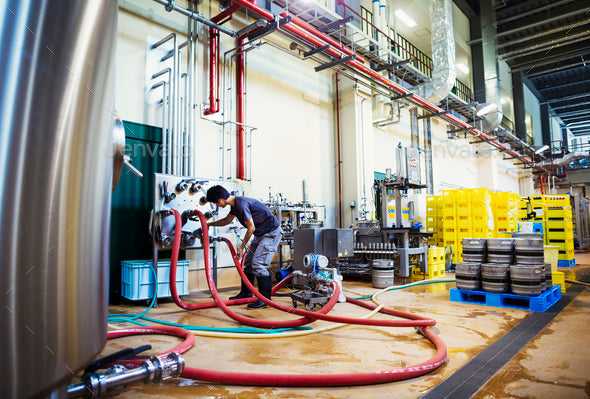How Long Should a Brewery Hose Last?
Like many questions surrounding the commercial brewing process, how long a beer brewing hose should last depends on a variety of factors. Brew hose material type, brew hose size, sanitary fittings selected, volume of media being conveyed, handling of a brew hose assembly, surrounding environment, and care taken to maintain or clean the beer transfer hose can make all the difference in its lifespan. Depending on these factors a brew hose can last anywhere from a couple of months to several years.
Tips to Make a Brew Hose Last:
Choose the Correct Size, Length, and Sanitary Fitting for Your Use
The exact layout and processing sequence of a commercial brewing facility can vary significantly. It is important to select the correct size and length of brew hose needed for the operation. Often brewers will use longer hoses to create flexible connections, but will lack an appropriate way to store them. Longer hoses also have a higher risk of being left on the ground and run over by a vehicle. Before buying a beer transfer hose consider the size of your facility, capacity needed to transfer beer, wart or water and the wall space or area you have to appropriately store the hose assembly within your facility. Picking a hose length and I.D. size suitable to the overall operation can avoid damage, storage issues and wear, while extending the life of the brewery hose assembly.
Sanitary Tri-Clamps made of stainless steel are the recommended fittings for a brew hose assembly. A crimp or band is used to seal the Tri-Clamp to the hose tube. (Read about the benefits and considerations of those processes in our blog post on crimping or banding a brewery hose.) When applied correctly these fittings provide a full seal between the clamp and gasket. Sizing of Tri-Clamps are based on the OD of the Tube instead of the width of the flange or ferrule. To make sure you’re selecting the correct Sanitary Tri-Clamp read our article on Tri-Clamp sizes or chat with one of our experts in the bottom righthand corner of your screen.
By selecting a hose assembly that is sized correctly and can accommodate your facility size, storage capabilities, and complete media transfers you can use the hose more effectively and for longer periods of time.
Brew Hose Material Type
When brewers upgrade to using brew hose, choosing the type of material for their use is one of the most important questions they consider. The construction and reinforcement of the hose will help with exterior handling and crush resistance, but it is the tube that will come into direct contact with the brewing process. For hose construction make sure reinforcement is present. Non-metal reinforcement is preferred. The tube should be FDA compliant with a homogenous, non-porous liner. This enables the tube to completely seal the water, wart or beer being transferred. This also prevents cracking or breaking of the tube which can lead to liquid coming into contact with rubber or metal before ultimately ending up in the brew.
Matching Hose with Application
It is easy to mismatch application with a food and beverage hose’s standards. If you are transferring media at a high temperature, you must make sure the application’s temperature is within the hose tube’s rating. Similarly, many processes require a sanitary hose assembly be connected at a bend. Make sure to check that the degree the hose is bended falls in line with its rated flexibility or bend radius. This can avoid kinking and extend the useful like of the brew hose.
Storage and Maintenance
Read our Article on Maintaining Hoses Appropriately. Proper storage of beer transfer hose should make sure the hose is stored in a way that will prevent bacteria growth as that will harm the final brew product. However, don’t sacrifice the support of your hose assembly’s storage in order to make sure it drains and dries appropriately. This leads to kinking, cracking, and breaking.
Repair Versus Replace
At times a sanitary brew hose is damaged in a way that makes it unusable, but repairable. It can be more cost efficient to repair an existing brewery hose rather than discard and replace the full assembly. Repair is usually an option for high quality hose that has an identifiable point or points of damage. At Brew Hose Supply we offer Purple Snake Hose repair for our customers. Read more about that brew hose repair service here.
Surrounding Environment
Is the brewery hose going to spend a fair amount of time on the floor where it could get crushed by a vehicle? Will it be hung over a sharp corner for long periods of time in-between use? Is there excessive exposure to the sun or outdoor elements? In today’s market there is a beer hose solution for most factors that can arise at a commercial brewery. It is important to think through how the hose will be used during regular operation to pick the right assembly and gain the most value. If a hose will be in the way of vehicle traffic finding one that is crush resistant may be more expensive on the front end, but will dramatically improve the value and long term life of the hose. Don’t try to find a one size fits all. Custom hoses can be created for unique situations.
While brewery hose with sanitary fittings represent a significant investment for commercial brewers, they are built to last when taken care of correctly. Need help? Chat with one of our experts or request a quote today. We provide no cost onsite recommendations for extending the life of commercial brewery hose.

